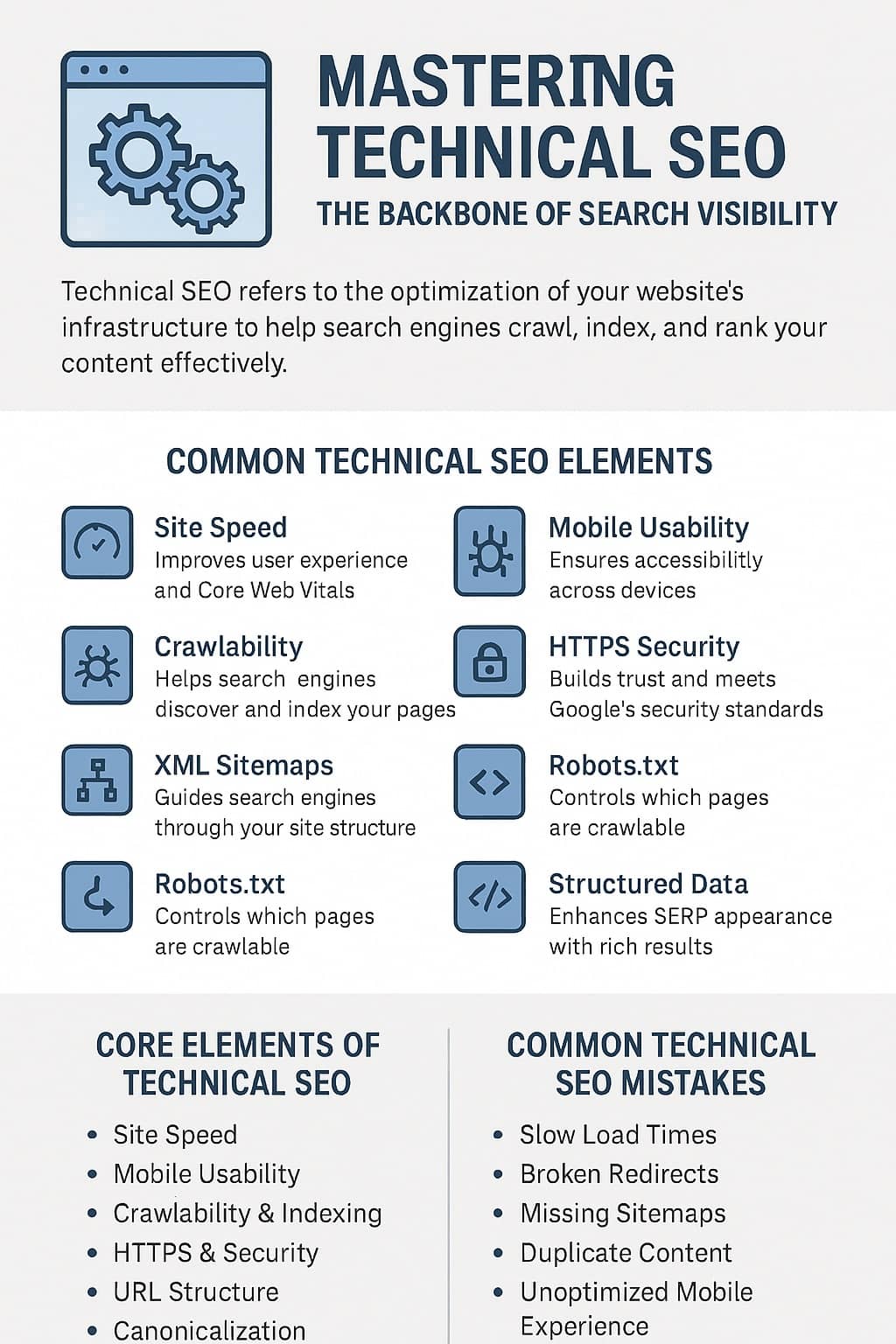table of contents
- 1. Site Speed & Performance
- 2. Mobile Optimization
- 3. Crawlability & Indexing
- 4. Site Architecture & Internal Linking
- 5. HTTPS & Security
- 6. Clean URL Structure
- 7. Structured Data (Schema Markup)
- 8. Redirects & Error Handling
- 9. Core Web Vitals
- 10. Bonus: NAP consistency
- 11. Bonus: Geo-targeted landing pages
- 12. Bonus: GMB integration
What are 12 Key Technical SEO Factors?
Technical SEO encompasses essential website optimization factors that improve search engine performance. Key elements include site speed, mobile responsiveness, robust crawlability, secure HTTPS protocols, and strategic site architecture. Core Web Vitals, XML sitemaps, canonical tags, and geo-targeted strategies play crucial roles in search rankings. Precise implementation of these technical components signals search engine credibility and boosts digital visibility. The complete optimization journey reveals deeper strategic insights.

1. Site Speed & Performance
The digital speedometer of website performance pivots critically on site speed and performance metrics. Technical SEO experts emphasize rapid load times as fundamental among key technical SEO factors. Mobile responsiveness demands optimization through tools like PageSpeed Insights and GTmetrix, which diagnose performance bottlenecks. Strategic implementations include minifying CSS/JavaScript, compressing images, and deploying lazy loading techniques. Server response time directly impacts user experience and search rankings, highlighting the importance of selecting robust hosting solutions. Efficient technical SEO requires continuous monitoring and proactive performance improvements to maintain a competitive digital presence.
2. Mobile Optimization
Mobile optimization represents a critical battleground in contemporary technical SEO strategy. Websites must prioritize responsive design to effectively serve local searchers using mobile devices. Key technical considerations include:
- Implementing precise tap target sizing for intuitive mobile interaction
- Configuring viewport settings for seamless screen adaptation
- Ensuring legible font sizes across diverse device dimensions
Technical experts recognize that mobile optimization transcends mere visual adjustment. It demands thorough performance engineering, addressing loading speed, content accessibility, and user experience. Successful mobile optimization directly correlates with improved search rankings, user engagement, and conversion potential, making it an indispensable component of modern SEO technical infrastructure.
3. Crawlability & Indexing
Optimizing website architecture extends beyond responsive design, requiring meticulous attention to search engine crawlability and indexing mechanisms. Robots.txt files play a critical role in guiding search engine bots, making certain they access and understand site structure without encountering unnecessary obstacles.
XML sitemaps provide thorough site mapping, enabling efficient crawling and indexing by search engines. Canonical tags strategically prevent duplicate content complications, signaling definitive page versions to search algorithms. Proper implementation of these technical elements guarantees search engines can effectively identify, interpret, and rank website content with maximum precision and minimal interference.
4. Site Architecture & Internal Linking
Architect website structures strategically to create intuitive navigation pathways that improve both user experience and search engine comprehension. Effective site architecture supports critical SEO objectives by establishing clear hierarchical relationships between pages.
- Implement logical navigation flows from homepage → category → service/product levels
- Utilize breadcrumbs to assist users and search engine crawlers in understanding site structure
- Develop keyword-rich internal linking strategies that guide crawler understanding and distribute page authority
Sophisticated internal linking and site architecture signal content relevance, boost crawlability, and optimize indexing potential for search engines.
5. HTTPS & Security
Websites evolving beyond structural integrity must prioritize secure communication protocols. HTTPS encryption alters web interactions, protecting user data transmission and establishing digital trust. An SSL certificate becomes a fundamental requirement, signaling website legitimacy to both users and search engines.
Search algorithms consistently reward secure websites, incrementally boosting rankings for domains implementing robust security measures. Mixed content warnings compromise user experience and diminish credibility, necessitating thorough secure asset loading across all web resources. Implementing HTTPS represents more than technical compliance—it demonstrates commitment to user privacy and digital security standards.
6. Clean URL Structure
Every strategic URL design plays a critical role in enhancing search engine comprehension and user navigation. Clean URL structures contribute greatly to improved SEO performance and user experience.
- Key principles for ideal URL design include:
- Use readable, keyword-rich URLs that clearly describe page content
- Minimize dynamic parameters and complex URL strings
- Implement consistent, logical URL hierarchies that reflect site architecture
Search engines prioritize clean, well-structured URLs as they provide immediate context about page relevance. By eliminating unnecessary complexity and incorporating meaningful keywords, websites can improve crawlability, increase click-through rates, and strengthen overall search engine optimization strategies.
7. Structured Data (Schema Markup)
Structured data serves as a powerful semantic communication protocol that allows search engines to interpret website content with greater precision and depth. By implementing schema.org markup, websites provide explicit context about their content, enabling search engines to generate rich results that boost visibility and click-through rates. Key schema types include LocalBusiness, Service, Review, and FAQ, which can greatly improve search appearance. Technical professionals recommend utilizing plugins like Rank Math or Yoast to simplify implementation, ensuring structured data is correctly integrated without manual coding complexities. Proper schema markup converts raw content into meaningful, machine-readable information.
8. Redirects & Error Handling
Robust redirect and error handling strategies form the backbone of technical SEO, ensuring a seamless user experience and maintaining critical link equity during site changes or content modifications. Effective management of site shifts and potential navigation errors involves several key technical practices:
- 301 redirects preserve page authority when content moves permanently
- Custom 404 pages prevent user frustration by offering alternative navigation paths
- Regular link audits help identify and resolve broken internal and external connections
Proactive redirect and error management minimizes negative user experience impacts, supports search engine crawling efficiency, and maintains website structural integrity and ranking potential.
9. Core Web Vitals
Core Web Vitals represent Google’s standardized metrics for measuring website performance and user experience, extending beyond traditional redirect and error management strategies. These metrics evaluate crucial aspects of web page loading, interactivity, and visual stability through three key indicators.
| Metric | Description |
|---|---|
| LCP | Load speed measurement |
| FID | Interactivity assessment |
| CLS | Visual stability evaluation |
| FCP | First content paint |
| TBT | Total blocking time |
Websites optimizing these metrics can markedly improve search rankings, user engagement, and overall digital performance. Precise technical implementation and continuous monitoring are fundamental for maintaining competitive web standards.
10. Bonus: NAP consistency
While often overlooked in technical SEO strategies, NAP (Name, Address, Phone Number) consistency plays a critical role in local search optimization and digital brand credibility. Search engines prioritize accuracy and uniformity across digital platforms when evaluating local business information.
Precision in NAP details empowers local SEO, signaling digital trustworthiness to search engine algorithms.
Key NAP consistency considerations include:
- Identical business name spelling across all online directories
- Precise address formatting with consistent street abbreviations
- Matching phone number formats (e.g., (555) 123-4567 vs. 555.123.4567)
Maintaining meticulous NAP alignment signals trustworthiness to search algorithms, potentially improving local search rankings and enhancing overall digital visibility.
11. Bonus: Geo-targeted landing pages
Geo-targeted landing pages represent a sophisticated strategic approach for businesses seeking to optimize local search performance and boost regional digital marketing effectiveness. These specialized web pages are meticulously crafted to address specific geographic audiences, incorporating localized keywords, region-specific content, and targeted metadata. By tailoring content to distinct geographic markets, organizations can markedly improve their local search engine rankings and enhance user engagement. Strategic implementation involves precise location-based signals, localized schema markup, and contextually relevant information that resonates with regional search intent and user preferences.
12. Bonus: GMB integration
Building upon localized digital marketing strategies, Google My Business (GMB) integration emerges as a powerful complement to geo-targeted landing pages. Technical SEO professionals recognize GMB as a critical optimization platform for boosting local search visibility and credibility.
Key advantages include:
Unlock local search potential through strategic Google My Business optimization with rich business context and precise geographical signals.
- Direct embedding of maps, reviews, and precise location data
- Enhanced search result appearances with rich business information
- Improved local search ranking signals through verified and thorough profiles
Strategically optimized GMB listings provide search engines with verified geographical context, enabling more accurate local search results and increasing the potential for improved organic visibility and user engagement.
Bonus: Core Technical SEO Factors

Technical SEO Definitions – Terms to Know
Crawl Budget
Your crawl budget is the number of pages Google is willing to scan on your site during a visit. If your site has lots of low-value or duplicate pages, Google might miss the ones that actually matter—like your service or landing pages. Managing this helps ensure your best content gets indexed and ranked.
Structured Data
Structured data is behind-the-scenes code that helps Google understand your content better. It can highlight things like reviews, services, or business info in search results—leading to eye-catching features like stars, maps, or FAQs. This boosts visibility and click-through rates.
Canonical Tags
Canonical tags tell search engines which version of a page is the “main” one. This prevents duplicate content issues—especially useful if your site has similar pages or product/service variations. It’s a simple way to protect your rankings and keep your site clean in Google’s eyes.
Core Web Vitals
Core Web Vitals are performance metrics Google uses to measure user experience. They focus on how fast your site loads, how stable it looks while loading, and how quickly users can interact. Better scores mean better rankings—and fewer people bouncing off your site.
301/302 redirect
A 301 redirect is permanent—it tells Google that a page has moved for good, and it should transfer SEO value to the new URL. A 302 is temporary and doesn’t pass that value. If you’re updating or consolidating pages, always use a 301 to preserve your hard-earned rankings.

